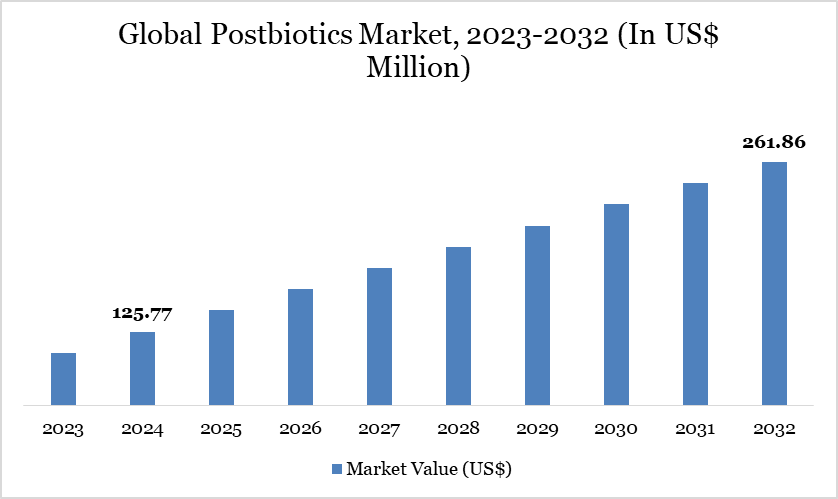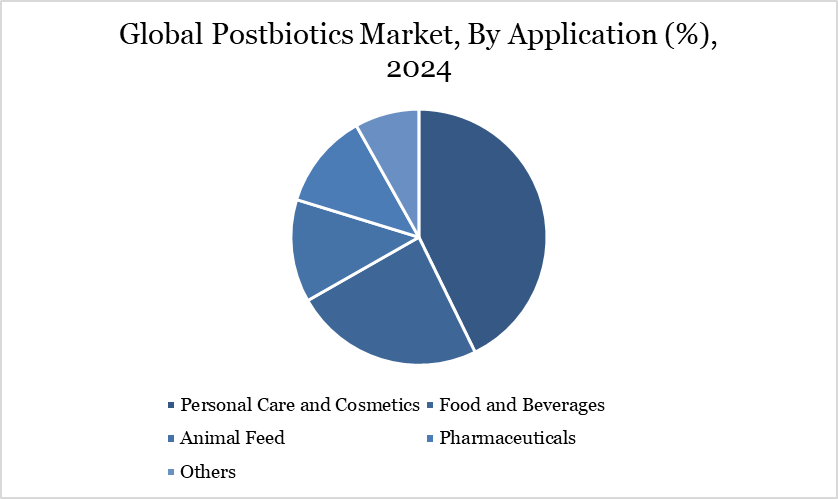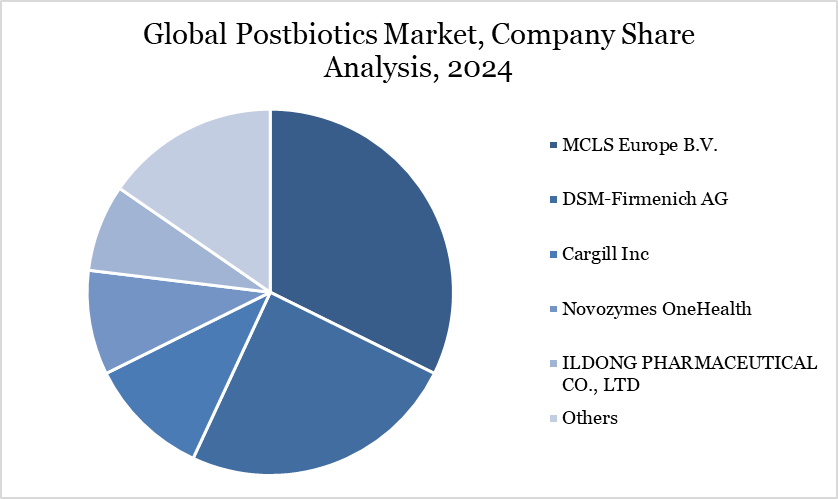Postbiotics Market Overview
Postbiotics Market reached US$ 125.77 million in 2024 and is expected to reach US$ 261.86 million by 2032, growing with a CAGR of 9.60% during the forecast period 2025-2032.
The global postbiotics market is experiencing robust growth, driven by increasing consumer demand for scientifically backed, stable, and effective gut health solutions. Postbiotics non-living microbial components or metabolites that deliver health benefits are gaining traction due to their enhanced stability, longer shelf life, and ease of formulation compared to live probiotics. A major driving factor is the rising awareness of gut microbiome health and its link to immunity, digestion, mental wellness, and chronic disease prevention.
For instance, in 2024, Leucine Rich Bio, South Asia’s leading microbiome-focused company, is celebrating the success of its #HappyGutMission a campaign dedicated to raising awareness about the importance of gut health. This initiative has played a key role in bringing gut wellness into everyday conversations by providing personalized insights that help individuals make informed dietary and lifestyle decisions. . Additionally, the growing use of postbiotics in infant nutrition, elderly care, and pet health is expanding the market scope.
Postbiotics Market Trend
Consumers especially in North America and Europe are increasingly viewing food beyond basic nutrition, choosing products that promote gut health, immunity, skin wellness, metabolic balance, weight management, and even sleep support. This shift is fueled by postbiotics’ stability advantage over live probiotics and strong efficacy for digestive and immune function, thus encouraging manufacturers to innovate with liquid, powder, capsule, and encapsulated forms targeting specific health outcomes.
For instance, the rise in personalized nutrition and sports-centric diets has created demand for bespoke postbiotic solutions. Brands are now exploring combinations tailored for athletic recovery and metabolic optimization an extension of the broader functional food trend, which also includes high-protein, gut-health-focused products. Additionally, research investment is fueling sophisticated encapsulation and fermentation technologies to enhance postbiotic delivery. Meanwhile, regulatory divergence presents both challenges and opportunities: Asia–Pacific countries (e.g., China, South Korea, India) are progressively formalizing postbiotic standards, while in the EU rigid novel food and health claim rules persist.

For more details on this report – Request for Sample
Market Scope
| Metrics | Details |
| By Form | Powder, Capsules, Tablets, Liquids, Others |
| By Application | Personal Care and Cosmetics, Food and Beverages, Animal Feed, Pharmaceuticals, Others |
| By Distribution Channel | Online Retail, Supermarkets/Hypermarkets, Drug Stores, Retail Stores, Others |
| By Region | North America, South America, Europe, Asia-Pacific, Middle East and Africa |
| Report Insights Covered | Competitive Landscape Analysis, Company Profile Analysis, Market Size, Share, Growth |
Postbiotics Market Dynamics
Strategies Adopted by the Companies
Strategic initiatives such as product launches, partnerships, and collaborations are playing a crucial role in driving the growth of the postbiotics market. Companies are increasingly investing in the development and commercialization of innovative postbiotic formulations to cater to the rising demand for gut health and immune-boosting products. New product launches help brands tap into emerging consumer needs, diversify their offerings, and enhance market visibility.
For instance, in 2024, Gaia Herbs is targeting gut and immune health with its new range of “full spectrum postbiotics” made with lactic acid bacteria from spontaneous fermentation in either Ginger-Turmeric, Sauerkraut, Ginger-Beet or Kimchi capsules.
Additionally, in 2024, Kerry has launched Plenibiotic, a new rice-derived postbiotic ingredient derived from Lactobacillus casei subsp. 327, which is formulated to improve digestive and skin health with clinical support from randomized, double-blind, placebo controlled trials. Such strategies not only enable faster market penetration but also build consumer trust through scientific validation, clinical support, and diversified applications across functional foods, beverages, and dietary supplements. These business moves collectively enhance awareness, accessibility, and adoption of postbiotic products globally.
High R&D Costs and Limited Clinical Evidence
High R&D costs and limited clinical evidence significantly restrain the growth of the postbiotics market by increasing development risk and reducing product credibility—especially in highly regulated sectors like food, supplements, and pharmaceuticals. Developing effective postbiotic products involves extensive research to identify the right bacterial strains, isolate beneficial compounds, and verify their health effects.
This requires sophisticated laboratory infrastructure, skilled microbiologists, and long-term investment in fermentation, inactivation, and delivery technologies. These processes are expensive and time-consuming, with no guaranteed commercial success. For example, identifying postbiotic metabolites like short-chain fatty acids (SCFAs) or inactivated bacterial components with proven immune or digestive benefits requires years of preclinical and human studies, which many small and mid-sized companies cannot afford.
Postbiotics Market Segment Analysis
The global postbiotics market is segmented based on form, application, distribution channel, and region.

Functional Innovation in Foods: How Postbiotics Are Revolutionizing the Food & Beverage Segment
The food and beverages segment is a significant driver of the postbiotics market, as consumers increasingly seek functional foods that offer health benefits beyond basic nutrition. Postbiotics, with their stability and versatility, are being seamlessly incorporated into a wide range of consumables such as dairy products, plant-based drinks, snacks, and cereals. Their heat-stable nature makes them ideal for food processing environments where traditional probiotics might not survive.
This has encouraged manufacturers to innovate and launch postbiotic-enriched products aimed at promoting gut health, immunity, and overall wellness. Postbiotics can withstand pasteurization, baking, and other food processing techniques that typically kill live probiotics. This makes them ideal for inclusion in beverages, baked goods, snacks, and even chocolates.
For instance, Kerry Group’s EpiCor, a yeast-derived postbiotic, is used in various functional food formats such as cereals and snack bars across the U.S. and Europe, catering to consumers who want immune-supporting foods with extended shelf life and no refrigeration requirements. Additionally, with the surge in clean-label, vegan, and plant-based foods, postbiotics provide a natural, non-GMO, and allergen-friendly option to boost the functional value of foods without adding live cultures that require refrigeration. In Europe, plant-based yogurt alternatives fortified with postbiotics from heat-inactivated Lactobacillus strains are gaining traction.
Postbiotics Market Geographical Share
Asia-Pacific’s Leadership in the Postbiotics Market: Tradition, Innovation, and Rising Health Demand
Asia-Pacific (APAC) dominates the postbiotics market due to its strong foundation in traditional fermented foods, rising health consciousness, growing middle-class population, and increasing demand for preventive healthcare. This region also benefits from advanced fermentation technology, government support for biotechnology, and a booming functional foods industry, especially in countries like Japan, China, South Korea, and India.
For instance, in 2024, investment in Asia biotechnology startups is on the rise, with those operating in the food, agriculture, bioenergy, and biomaterials spaces across the Asia-Pacific raising nearly $3.5 billion in the last three years, up over 140% against the three years prior. Additionally, in 2022, 55% of the world's population (approximately 4.4 billion people) will live in Asia, including 649 million people aged 60 years and above, accounting for 58.5% of the global aging population.
By 2050, this number is expected to double to 1.3 billion. Thus, APAC dominates the postbiotics market through a blend of traditional dietary familiarity, rising health awareness, active biotech investments, and innovation-led manufacturing capabilities, making it a hub for both consumption and production of postbiotic-based products.
Sustainability Analysis
Postbiotics, unlike probiotics, do not require live culture preservation, cold-chain logistics, or specialized storage. Their heat stability reduces energy consumption associated with refrigeration during transportation and storage, leading to lower carbon emissions. This enhances sustainability throughout the supply chain—from production to retail. Additionally, postbiotic production often utilizes by-products of microbial fermentation (such as yeast or bacterial biomass), which can reduce food waste and promote circular bioeconomy practices.
By supporting preventive health through immune and gut wellness, postbiotics can reduce the long-term burden on healthcare systems. This aligns with the broader goals of social sustainability, as healthier populations reduce public health costs and increase workforce productivity. Their integration into affordable staple products like cereals, snacks, and beverages makes them accessible to a wider population.
Postbiotics Market Major Players
The major global players in the market include MCLS Europe B.V., DSM-Firmenich AG, Cargill Inc, Novozymes OneHealth, ILDONG PHARMACEUTICAL CO., LTD, ADM, Shanghai Novanat Co., Ltd, Sirius Pet Biologics Pte Ltd, POSTBIOTICA S.R.L., Lactobio A/S and among others.

Key Developments
In 2023, Food processing and packaging company Tetra Pak (Lausanne, Switzerland) is partnering with microbiome-ingredients firm AB Biotek Human Nutrition & Health (Peterborough, UK) to develop postbiotic ingredients for the food and drink market. The companies say they are now working together to develop a range of innovative food applications for a postbiotic ingredient.
In 2025, ADM has announced a partnership with Japan’s Asahi Group to market and distribute a new postbiotic ingredient designed to support sleep, stress relief, and mood enhancement. Developed from Lactobacillus gasseri through extensive research on lactic acid bacteria, the ingredient is backed by eight clinical trials confirming its functional benefits.
Why Choose DataM?
Data-Driven Insights: Dive into detailed analyses with granular insights such as pricing, market shares and value chain evaluations, enriched by interviews with industry leaders and disruptors.
Post-Purchase Support and Expert Analyst Consultations: As a valued client, gain direct access to our expert analysts for personalized advice and strategic guidance, tailored to your specific needs and challenges.
White Papers and Case Studies: Benefit quarterly from our in-depth studies related to your purchased titles, tailored to refine your operational and marketing strategies for maximum impact.
Annual Updates on Purchased Reports: As an existing customer, enjoy the privilege of annual updates to your reports, ensuring you stay abreast of the latest market insights and technological advancements. Terms and conditions apply.
Specialized Focus on Emerging Markets: DataM differentiates itself by delivering in-depth, specialized insights specifically for emerging markets, rather than offering generalized geographic overviews. This approach equips our clients with a nuanced understanding and actionable intelligence that are essential for navigating and succeeding in high-growth regions.
Value of DataM Reports: Our reports offer specialized insights tailored to the latest trends and specific business inquiries. This personalized approach provides a deeper, strategic perspective, ensuring you receive the precise information necessary to make informed decisions. These insights complement and go beyond what is typically available in generic databases.
Target Audience 2024
Manufacturers/ Buyers
Industry Investors/Investment Bankers
Research Professionals
Emerging Companies